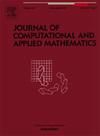具有排斥性内拐点的一维奇异摄动抛物对流扩散系统的有效数值方法
IF 2.1
2区 数学
Q1 MATHEMATICS, APPLIED
Journal of Computational and Applied Mathematics
Pub Date : 2025-04-29
DOI:10.1016/j.cam.2025.116728
引用次数: 0
摘要
本文提出并研究了一种有效求解空间域内点对流系数为零的一维抛物型奇摄动系统的数值方法。我们将注意力集中在两个方程中具有相同扩散参数的情况;同样,我们假定对流系数上有足够的符号,以使内部拐点是排斥型的。在这些条件下,如果问题的数据由连续函数组成,则精确进化解通常在空间域的端点处具有规则的边界层。为了解决这类问题,我们将分数阶隐式欧拉方法与经典逆风格式相结合,并将其定义在特殊的Shishkin型网格上。所得数值方法在时间上达到一阶一致收敛,在空间上达到近一阶收敛。文中给出了不同试验问题的数值结果,在实践中证实了该数值算法的一致收敛性,并与同类问题的经典数值方法进行了比较。本文章由计算机程序翻译,如有差异,请以英文原文为准。
An efficient numerical method for 1D singularly perturbed parabolic convection–diffusion systems with repulsive interior turning points
In this work, we propose and study a numerical method to solve efficiently one-dimensional parabolic singularly perturbed systems of convection–diffusion type, for which the convection coefficient is zero at an interior point of the spatial domain. We focus our attention on the case of having the same diffusion parameter in both equations; as well we assume adequate signs on the convective coefficients in order to the interior turning point is of repulsive type. Under these conditions, if the data of the problem are composed by continuous functions, the exact evolutionary solution, in general, has regular boundary layers at the end points of the spatial domain. To solve this type of problems, we combine the fractional implicit Euler method and the classical upwind scheme, defined on a special mesh of Shishkin type. The resulting numerical method reach uniform convergence of first order in time and almost first order in space. Numerical results obtained for different test problems are shown which corroborate in practice the uniform convergence of the numerical algorithm and also their computational efficiency in comparison with classical numerical methods used for the same type of problems.
求助全文
通过发布文献求助,成功后即可免费获取论文全文。
去求助
来源期刊
CiteScore
5.40
自引率
4.20%
发文量
437
审稿时长
3.0 months
期刊介绍:
The Journal of Computational and Applied Mathematics publishes original papers of high scientific value in all areas of computational and applied mathematics. The main interest of the Journal is in papers that describe and analyze new computational techniques for solving scientific or engineering problems. Also the improved analysis, including the effectiveness and applicability, of existing methods and algorithms is of importance. The computational efficiency (e.g. the convergence, stability, accuracy, ...) should be proved and illustrated by nontrivial numerical examples. Papers describing only variants of existing methods, without adding significant new computational properties are not of interest.
The audience consists of: applied mathematicians, numerical analysts, computational scientists and engineers.

 求助内容:
求助内容: 应助结果提醒方式:
应助结果提醒方式:


